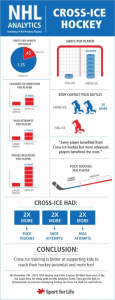Proof that small ice hockey is better for kids
 For the last few years, a debate has raged in the hockey world. On one side you have hockey specialists that recommend that kids aged 8 and younger play on a smaller surface (often half-ice). On the other side of the debate are the hockey purists and parents who believe that half-ice hockey is not “real hockey”.
For the last few years, a debate has raged in the hockey world. On one side you have hockey specialists that recommend that kids aged 8 and younger play on a smaller surface (often half-ice). On the other side of the debate are the hockey purists and parents who believe that half-ice hockey is not “real hockey”.
For the advocates of a small ice surface for small kids, the main issue is proportion. A full ice surface is simply too big for younger kids.
In these short videos adults had to play hockey and soccer on surfaces that were proportionally as large as a full surface is for an 8-year-old. Their comments give us a sense of how a young child feels playing on a full-size ice sheet.
“The ice looks so big, it’s overwhelming,” one man says. “I barely got to touch the puck,” says another. “The other players are so far away, you can’t catch them, I gave up,” one player admits. And this revelation: “It’s no fun.”
Science to the rescue
This is where the science of data analytics comes in. Data analytics is when technology is used to gather data about different components of a sport. The advantage of data analytics is that it provides evidence-based facts.
Back in 2014, the National Hockey League (NHL) data-analytics division brought their professional expertise and technology to Detroit and gathered data from kids 8 and younger who had experienced playing on both a full ice and a small ice sheet.
The facts they captured tell a clear story: Kids who played on the cross-ice surface touched the puck more often, attempted more passes, and took twice the number of shots as kids who played on a full ice.
The infographic below was created by Sport for Life and is a visual representation of the data captured by the NHL data-analytics team.
Double everything that’s good
I’m no scientist, but as a hockey dad, the conclusion that I take away is this: Kids who played on the smaller ice surface had a better opportunity to improve their skills and, more importantly, they had twice as much fun.
Richard Monette January 18, 2018
